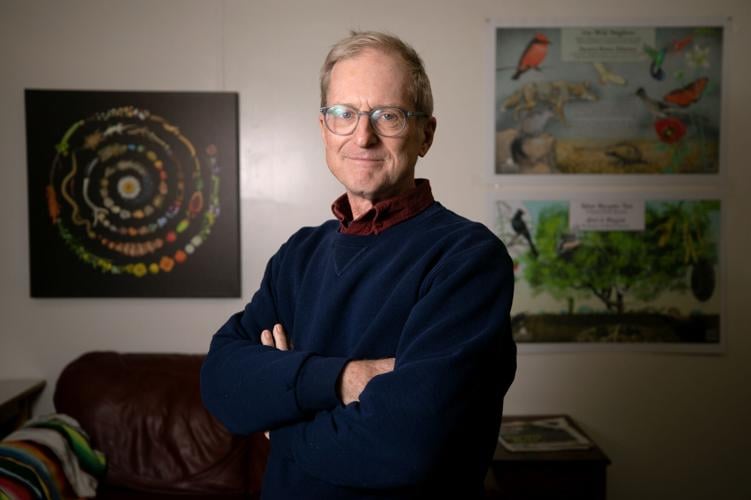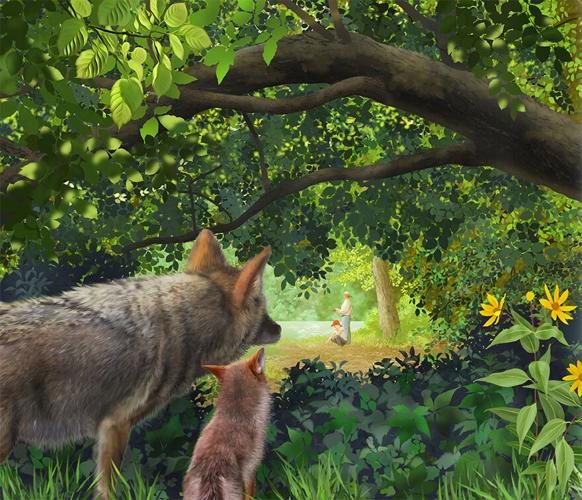Artist Paul Mirocha rarely encounters coyotes in his downtown Tucson neighborhood, but he saw one the morning he went to meet author Barbara Kingsolver to talk about the children’s book they were making together.
“It felt like an omen,” the accomplished illustrator said.
Mirocha has teamed with the award-winning author and her daughter, Lily, on a new educational picture book called “Coyote’s Wild Home.”
The book follows a coyote and a pup and a girl and her grandfather as they wander through the same Appalachian forest in search of adventure.
The coyotes hunt and frolic, the humans fish and camp, and the reader learns about the important role these adaptable predators play across their growing range.
Some people consider coyotes a pest or a danger, Mirocha said, but they are just doing what is necessary to survive, just like us. “The story is to accept that and respect them,” he said.
“Coyote’s Wild Home” is set for release on Nov. 28 through The Gryphon Press.

Tucson-based illustrator Paul Mirocha collaborated with award-winning author Barbara Kingsolver and her daughter, Lily, on a children’s book which is set to release on November 28. The title of the book, “Coyote's Wild Home.”
It is the first published book for Lily Kingsolver, an environmental educator in Florida, and the first children’s book for Barbara Kingsolver, the best-selling author who launched her career in Tucson and won the Pulitzer Prize for Fiction this year for her latest novel “Demon Copperhead.”
Mirocha has illustrated more than 40 books, including several other picture books for children.
He said he is probably best known locally as a long-time artist in residence at the university’s Desert Laboratory on Tumamoc Hill and for the artwork he did for “The Sonoran Desert: A Literary Field Guide,” an acclaimed, genre-blending 2016 anthology by The University of Arizona Press.
His illustrations also have appeared in previous books by Kingsolver, including her 2002 essay collection “Small Wonder” and her 2000 novel “Prodigal Summer,” in which coyotes play a central role.
He said he and Kingsolver are old friends who first met in the 1980s when they both worked at the U of A’s Office of Arid Land Studies.

The cover of the new educational picture book by award-winning author Barbara Kingsolver, her daughter, Lily Kingsolver, and Tucson illustrator Paul Mirocha.
Back then, Mirocha said, she was earning a paycheck as a science writer and working on a novel at night “while she figured out what she wanted to do next.” That little side project turned out to be “The Bean Trees,” her first best-seller, set in Tucson.
Mirocha said Kingsolver tried her hand at children’s books in the past, but she scrapped them because she didn’t like how they turned out. It was Lily’s interest in the idea that convinced Kingsolver to sign on to the coyote book, he said.
“She called and asked me to illustrate it. Of course, I couldn’t say no,” Mirocha said.
He said the deadlines for the picture book were intense. He had to produce 32 large spreads for the book in about 8 months, using a digital painting technique he has mastered. “At some points I was doing a page or spread per week,” he said.
Being an illustrator can be lonely, Mirocha said, but this project was just the opposite: It was a lively collaboration with a dear and loyal friend.
In an Instagram post about the project, Kingsolver said she and her daughter “decided that after centuries of bad wolves and bears, predators needed better representation in children’s books.”
She said Mirocha “brought our best dreams to life.”
The work began in September of last year when Kingsolver invited the artist to her home in southwestern Virginia to discuss the book and learn about its setting.
He was leaving his house in Armory Park to catch his early morning flight to the East Coast when the aforementioned coyote trotted across the road in front of him in an industrial area about two blocks from home.

A coyote and pup watch a little girl and her grandfather in one of Tucson illustrator Paul Mirocha's paintings for the new children's book "Coyote's Wild Home."
“I slowed down, and it turned to look at me briefly, then was gone,” he said. “Whenever I see a coyote, I see it as a communication somehow. I think, ‘Something unexpected is going to happen, and it’s best not to judge it as good or bad.’”
During the week-long book-planning visit, Kingsolver and her husband, Steve Hopp, put Mirocha up in a cabin about a quarter of a mile from their house and introduced him to their lush, private hollow in the Appalachians. The forest locations in the book are based on real spots the author and her family know well.
“I went to all these places and got really inspired. It was like going to scenes from a movie,” Mirocha said. “It was so different than the Sonoran Desert. It was just exploding with green. It was a totally new exploration.”
The trip also served as a crash course in the botany of Appalachia. He made sketches and took “tons of reference photos,” as Kingsolver and Hopp acted as teachers and tour guides.
At one point, they picked native pawpaw fruit — sort of a cross between a banana and a mango that grows in eastern forests — and Kingsolver baked them into a pie.
“They showed me all sorts of stuff,” Mirocha said. “In order to do the drawing, you need to learn the science behind it.”
Early in the visit, he and Kingsolver sat together at her kitchen table — and Lily joined them over Zoom — so they could sketch out a storyboard for the entire book.
“That was just indescribably fun,” Mirocha said of the whole experience. “It was really a treat to work with Barbara and Lily.”
Reporter Henry Brean filmed this coyote chorus at Crooked Tree Golf Course on Dec. 27, 2022.








